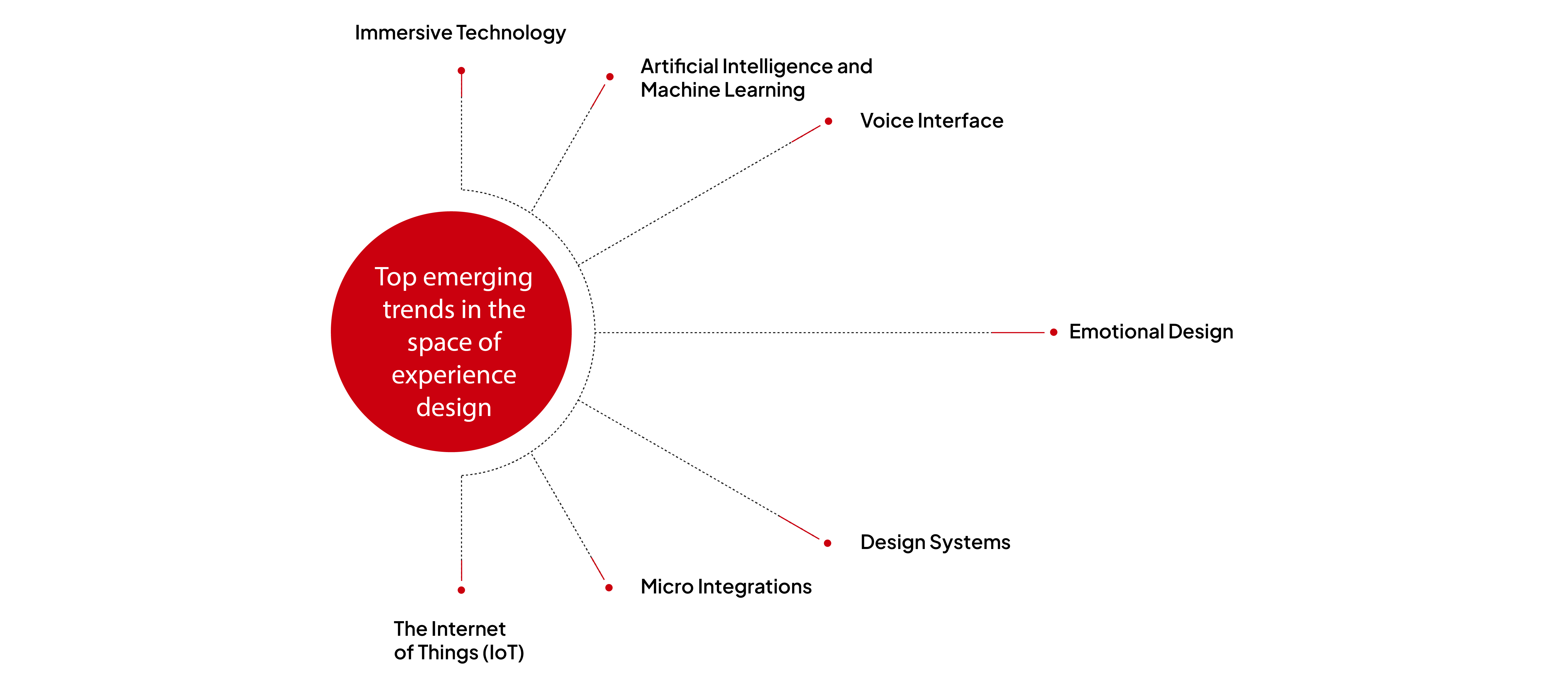Experience design, or XD, is the process of designing products, services, and environments that create a meaningful, memorable, and desirable experience for users. XD combines elements of design, psychology, and technology to create engaging and intuitive experiences that enhance user satisfaction and loyalty. Experience design is a crucial aspect of digital transformation and is constantly evolving to meet changing user needs and technology advancements. As technology continues to advance, experience designers must stay ahead of the curve to ensure they are creating user-centric experiences that are not only functional but also enjoyable. In the future, experience design will play an even greater role in shaping the way we interact with technology and brands.
Top emerging trends in the space of Experience design

1. Immersive Technology
Immersive technology, such as virtual and augmented reality, will play a crucial role in experience design in the future. Companies are now using these technologies to create interactive and engaging customer experiences. With the help of these technologies, designers will be able to create more engaging, interactive, and memorable experiences for users.
2. Artificial Intelligence and Machine Learning
AI and ML are changing the way we interact with technology and creating new opportunities for experience design. AI-powered chatbots, voice assistants, and personalized recommendations are just a few examples of how this technology is enhancing the user experience. AI and ML will play a significant role in experience design by providing designers with the tools to create more personalized, intelligent, and efficient experiences. AI will help designers automate repetitive tasks, analyse user behaviour, and provide recommendations to optimize experiences.
3. Voice Interface
Voice interface is a new and growing trend in experience design, with the increasing popularity of voice-controlled devices like Amazon Echo and Google Home. Designers will need to consider the unique challenges of designing for voice interface, such as creating experiences that are easy to use and understand, and that can respond to natural language inputs. At CoreFlex, we constantly strive to incorporate voice intelligence into our designs.
4. Emotional Design
Emotional design is the process of designing experiences that evoke emotions and feelings in users. With the rise of artificial intelligence and machine learning, experience designers are now able to create emotionally responsive experiences that adapt to the user’s mood. Emotional design will become increasingly important as more products and services are designed to meet the emotional needs of users, and as technology continues to blur the line between digital and physical experiences.
5. Design Systems
Design systems are collections of design elements and guidelines that help designers create consistent and cohesive experiences across different platforms and devices. Design systems will become increasingly important in experience design as designers need to create experiences that are consistent across multiple devices and platforms.
6. Microinteractions
Microinteractions are small, interactive elements within a product or service that enhance the overall user experience. They can range from animations and sound effects to simple interactions such as pulling to refresh a page. Microinteractions will become increasingly important in experience design as designers need to create experiences that are intuitive, engaging, and memorable.
7. The Internet of Things (IoT)
The growing number of connected devices is creating new opportunities for experience design. IoT devices are able to gather and share data, creating a more personalized and connected experience for users. Designing for IoT requires an understanding of how devices interact and how to create seamless experiences across different devices.
The field of experience design is constantly evolving, and as technology advances, new trends and opportunities will continue to emerge. It is important for experience designers to stay informed and adapt their practices to ensure they are creating user-centric experiences that are both functional and enjoyable. Whether it’s AI, VUIs, VR/AR, IoT, responsive design, micro-interactions, or accessibility and inclusivity, designers must be prepared to embrace the future of experience design and continue to push the boundaries of what is possible. With the rise of new technologies such as artificial intelligence, virtual reality, and the Internet of Things, designers will have access to a wealth of tools to help them create immersive and personalized experiences. The key for designers will be to stay on top of these trends and to continue to push the boundaries of what is possible in the field of experience design.









